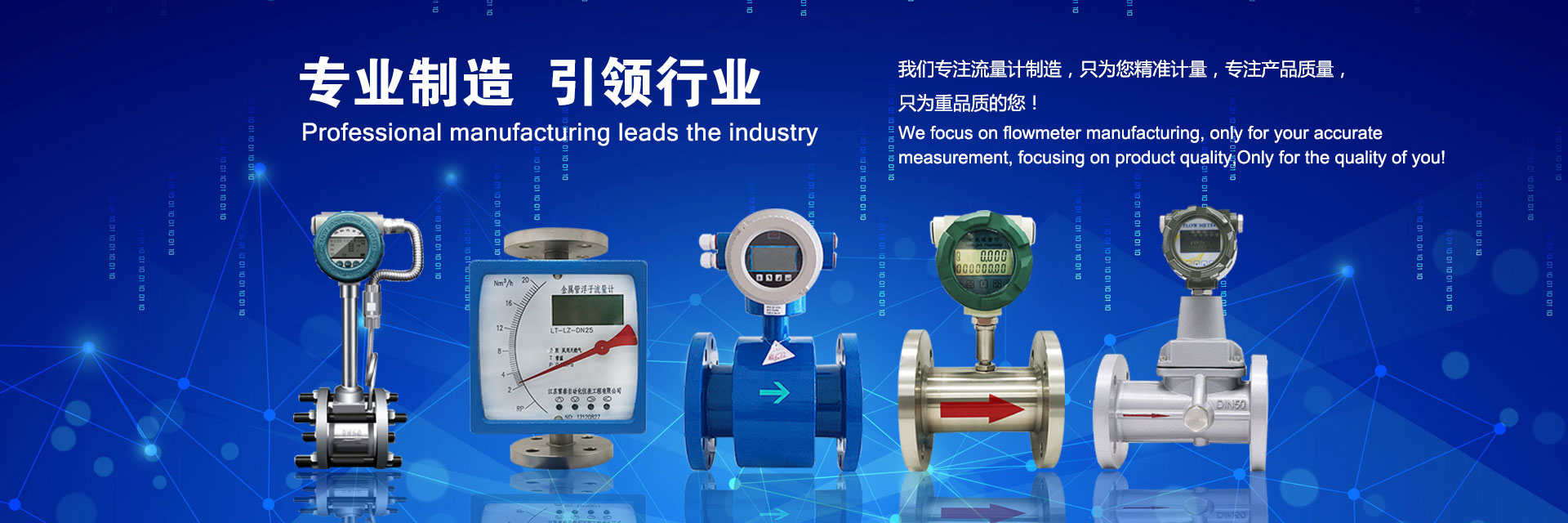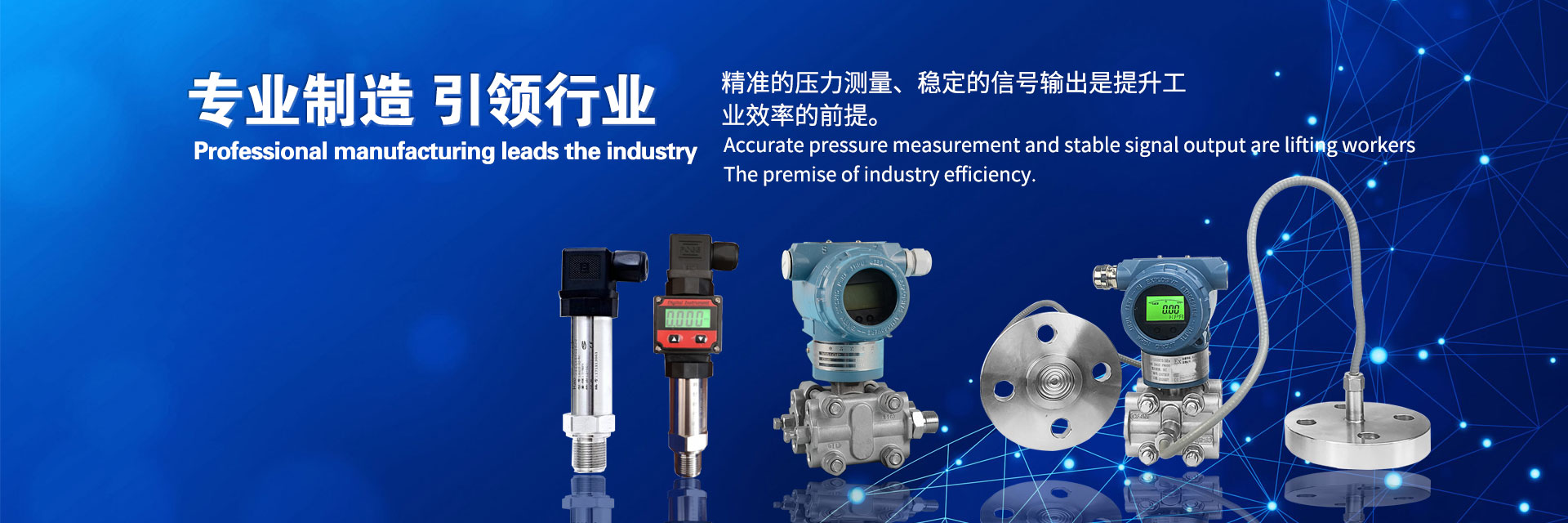Company news
推荐资讯
免费咨询热线
+086-0517-86998608Company news
一、 差压变送器的工作原理:
1、 Working principle of differential pressure transmitter:
来自双侧导压管的差压直接作用于变送器传感器双侧隔离膜片上,通过膜片内的密封液传导至测量元件上,测量元件将测得的差压信号转换为与之对应的电信号传递给转换器,经过放大等处理变为标准电信号输出。
The differential pressure from the two-sided pressure pipes directly acts on the two-sided isolation diaphragm of the transmitter sensor, and is transmitted to the measuring element through the sealing liquid in the diaphragm. The measuring element converts the measured differential pressure signal into corresponding electrical signal and transmits it to the converter. After amplification and other processing, it becomes the standard electrical signal output.
二、差压变送器的几种应用测量方式:
2、 Several application measurement methods of differential pressure transmitter:
1. 与节流元件相结合,利用节流元件的前后产生的差压值测量液体流量。
1. Combined with the throttling element, the liquid flow is measured by the differential pressure between the front and rear of the throttling element.
2. 利用液体自身重力产生的压力差,测量液体的高度。
2. Measure the height of the liquid by using the pressure difference generated by the gravity of the liquid itself.
3. 直接测量不同管道、罐体液体的压力差值。
3. Directly measure the pressure difference of liquid in different pipes and tanks.
三、 应用中的故障判断及分析
3、 Fault diagnosis and analysis in application
变送器在测量过程中,常常会出现一些故障,故障的及时判定分析和处理,对正在进行了生产来说是至关重要的。我们根据日常维护中的经验,总结归纳了一些判定分析方法和分析流程。
In the measurement process of transmitter, there are often some faults. It is very important to judge, analyze and deal with the faults in time. According to our daily maintenance experience, we summarized some judgment analysis methods and analysis processes.
1. 调查法:回顾故障发生前的打火、冒烟、异味、供电变化、雷击、潮湿、 误操作、误维修。
1. Investigation method: review the ignition, smoke, odor, power supply change, lightning, humidity, misoperation and maintenance before the failure.
2. 直观法:观察回路的外部损伤、导压管的泄漏,回路的过热,供电开关状态等。
2. Intuitive method: observe the external damage of the circuit, leakage of the pressure pipe, overheating of the circuit, power supply switch state, etc.
3. 检测法:
3. Detection method:
1) 断路检测:将怀疑有故障的部分与其它部分分开来,查看故障是否消失,如果消失,则确定故障所在,否则可进下步查找,如:智能差压变送器不能正常Hart远程通讯,可将电源从表体上断开,用现场另加电源的方法为变送器通电进行通讯,以查看是否电缆是否叠加约2kHz的电磁信号而干扰通讯。
1) Open circuit detection: separate the suspected fault part from other parts to check whether the fault disappears. If it disappears, determine the fault location. Otherwise, the next step can be found. For example, if the intelligent differential pressure transmitter cannot communicate normally with HART remote communication, the power supply can be disconnected from the body, and the transmitter can be powered on for communication by adding additional power on site to check whether the cable is overlapped About 2KHz electromagnetic signal interferes with communication.
2) 短路检测:在保证安全的情况下,将相关部分回路直接短接,如:差变送器输出值偏小,可将导压管断开,从一次取压阀外直接将差压信号直接引到差压变送器双侧,观察变送器输出,以判断导压管路的堵、漏的连通性。
2) Short circuit detection: under the condition of ensuring safety, the relevant part of the circuit is directly short circuited. For example, if the output value of the differential transmitter is too small, the pressure conducting pipe can be disconnected, and the differential pressure signal can be directly led to both sides of the differential pressure transmitter from the outside of the primary pressure taking valve, and the output of the transmitter shall be observed to judge the plugging and leakage connectivity of the pressure pipeline.
3) 替换检测:将怀疑有故障的部分更换,判断故障部位。如:怀疑变送器电路板发生故障,可临时更换一块,以确定原因。
3) Replacement detection: replace the part suspected of failure and judge the fault position. For example, if the transmitter circuit board is suspected to be faulty, a temporary replacement can be made to determine the cause.
4)分部检测:将测量回路分割成几个部分,如:供电电源、信号输出、信号变送、信号检测,按分部分检查,由简至繁,由表及里,缩小范围,找出故障位置。
4) Division detection: the measurement circuit is divided into several parts, such as: power supply, signal output, signal transmission, signal detection, according to the parts of inspection, from simple to complex, from the surface to the inside, narrow the scope, find out the fault location.
四、几个典型测量回路的故障分析
4、 Fault analysis of several typical measuring circuits
下面我仅以导压管故障为例,来分析差压变送器测量回路故障。
Now I only take the pressure pipe fault as an example to analyze the differential pressure transmitter measurement circuit fault.
1. 导压管堵塞:
1. The pressure pipe is blocked:
在仪表维护中,由于差压变送器导压管排放不及时,或介质脏、粘等原因,正负导压管堵塞是经常发生的事。
In the instrument maintenance, because the differential pressure transmitter pressure pipe discharge is not timely, or the medium is dirty, sticky and other reasons, the positive and negative pressure pipe is often blocked.
当实际流量由F前减小到F后时,管道中的静压也相应的降低,设降低值为P0;同时,当实际流量下降至F后时,P-值也要因为管内流体流速的降低而升高,设升高值为P0’。
When the actual flow rate decreases from before f to after F, the static pressure in the pipeline will also decrease accordingly, and the decrease value is set as P0; at the same time, when the actual flow rate decreases to F, the p-value will also increase because of the decrease of the fluid velocity in the pipe, and the increase value is set as P0 '.
即:△P=( P+-P0 )-( P-+P0′)此时变送器输出值应减小。
That is, △ P = (P + - P0) - (P - + P0 '), and the output value of the transmitter should be reduced.
2. 正导压管泄漏:
2. Leakage of positive pressure pipe:
实际上,当泄漏量非常小的时候,由于种种原因,工艺操作或仪表维修护人员很难发现,只有当泄漏量大,所测流量与实际流量相比有较大误差时才会发现,这时即使是实际流量上升,总是△P泄漏后<<△ P泄漏前,F泄漏后<3. 平衡阀泄漏:
In fact, when the leakage is very small, due to various reasons, the process operation or instrument maintenance personnel can hardly find it. Only when the leakage is large and there is a large error between the measured flow and the actual flow, even if the actual flow rate rises, it is always after △ P leakage < < before △ P leakage and after f leakage < 3
设泄漏前压力为P1,泄漏后压力为P2, P1= P1+- P1- ,F1为平衡阀泄漏前的变送器输出值,F2为平衡阀泄漏后的变送器输出值。
Set the pressure before leakage as P1, the pressure after leakage as P2, P1 = P1 + - P1 -, F1 is the output value of transmitter before balance valve leakage, and F2 is the output value of transmitter after balance valve leakage.
我们假设管道内流体流量在没有变化的情况下做分析,设泄漏的压力为PS,
We assume that the fluid flow rate in the pipeline does not change, and the leakage pressure is PS,
则:泄漏后的正负导压管的静压为:
Then: the static pressure of the positive and negative pressure pipes after leakage is:
P2+= P1+-PS,P2-= P1-+ PS
P2+= P1+-PS,P2-= P1-+ PS
P2= P2+- P2- = P1-2 PS,
P2= P2+- P2- = P1-2 PS,
根据差压与流量的关系得出F24. 气体流量导压管积液情况下的变送器测量误差:
According to the relationship between differential pressure and flow rate, F24 is obtained
设正导压管取压点压力为P0+,负导压管取压点压力为P0-,变送器">差压变送器正端压力为P1+,变送器">差压变送器负端压力为P1-。
Set the pressure of positive pressure pipe pressure point as P 0 +, negative pressure pipe pressure point as P 0 -, pressure of transmitter "> positive end of differential pressure transmitter is P1 +, and pressure of negative end of transmitter" > differential pressure transmitter is P1 -.
P0= P0+- P0-
P0= P0+- P0-
P1= P1+- P1-
P1= P1+- P1-
正常测量下:
Under normal measurement:
P0= P1
P0= P1
设正常测量状态下的流量为F,则 F=K
If the flow rate under normal measurement condition is f, then f = K
这里 K为常系数。
Here K is a constant coefficient.
设液体水的密度为ρ,则在正导压管积液高度为h+,负导压管积液高度为h-的情况下:
If the density of liquid water is ρ, then when the height of effusion in positive pressure pipe is H +, and that in negative pressure pipe is H -:
P1+= P0++ρgh+
P1+= P0++ρgh+
P1-= P0-+ρgh-
P1-= P0-+ρgh-
P1= P1+- P1-= (P0+)+(ρ h+)-( P-+ρ h-)= P+ρ (h+-h-)
P1= P1+- P1-= (P0+)+(ρ h+)-( P-+ρ h-)= P+ρ (h+-h-)
则变送器输出为:
Then the transmitter output is:
F=K
F=K
当h+>h-时 变送器实际测得的差压增大,输出流量信号增大。
When H + > H -, the differential pressure measured by the transmitter increases and the output flow signal increases.
当h+这里,由于正压导管取压方式的原因,随着时间的增加,h+逐渐大于h-,测得的流量也增大。
When H + here, due to the positive pressure pipe pressure measurement method, with the increase of time, H + is gradually greater than H -, and the measured flow also increases.
相关新闻
- Fault diagnosis and analysis of differential pressure transmitter in application 20-09-25
- Application and principle of bimetal thermometer 20-09-25
- How to install buoy level gauge 20-09-25
- Application of pH controller in acid alkali automatic control 20-09-25
- Cooling capacity measurement system of chilled water 20-09-25
- Advantage analysis of intelligent orifice flowmeter in actual measurement 20-07-29
- Problems encountered in operation of vortex flowmeter manufacturers 20-07-29
- Requirements for installation environment of vortex flowmeter 20-07-29







